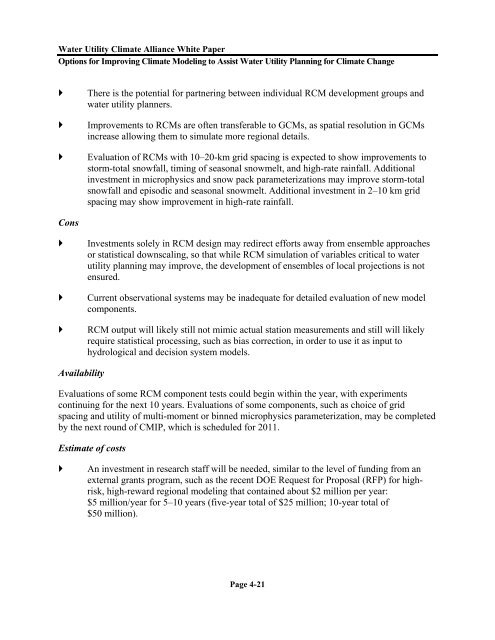Options for Improving Climate Modeling to Assist Water Utility ...
Options for Improving Climate Modeling to Assist Water Utility ...
Options for Improving Climate Modeling to Assist Water Utility ...
Create successful ePaper yourself
Turn your PDF publications into a flip-book with our unique Google optimized e-Paper software.
<strong>Water</strong> <strong>Utility</strong> <strong>Climate</strong> Alliance White Paper<br />
<strong>Options</strong> <strong>for</strong> <strong>Improving</strong> <strong>Climate</strong> <strong>Modeling</strong> <strong>to</strong> <strong>Assist</strong> <strong>Water</strong> <strong>Utility</strong> Planning <strong>for</strong> <strong>Climate</strong> Change<br />
<br />
<br />
<br />
There is the potential <strong>for</strong> partnering between individual RCM development groups and<br />
water utility planners.<br />
Improvements <strong>to</strong> RCMs are often transferable <strong>to</strong> GCMs, as spatial resolution in GCMs<br />
increase allowing them <strong>to</strong> simulate more regional details.<br />
Evaluation of RCMs with 10–20-km grid spacing is expected <strong>to</strong> show improvements <strong>to</strong><br />
s<strong>to</strong>rm-<strong>to</strong>tal snowfall, timing of seasonal snowmelt, and high-rate rainfall. Additional<br />
investment in microphysics and snow pack parameterizations may improve s<strong>to</strong>rm-<strong>to</strong>tal<br />
snowfall and episodic and seasonal snowmelt. Additional investment in 2–10 km grid<br />
spacing may show improvement in high-rate rainfall.<br />
Cons<br />
<br />
<br />
<br />
Investments solely in RCM design may redirect ef<strong>for</strong>ts away from ensemble approaches<br />
or statistical downscaling, so that while RCM simulation of variables critical <strong>to</strong> water<br />
utility planning may improve, the development of ensembles of local projections is not<br />
ensured.<br />
Current observational systems may be inadequate <strong>for</strong> detailed evaluation of new model<br />
components.<br />
RCM output will likely still not mimic actual station measurements and still will likely<br />
require statistical processing, such as bias correction, in order <strong>to</strong> use it as input <strong>to</strong><br />
hydrological and decision system models.<br />
Availability<br />
Evaluations of some RCM component tests could begin within the year, with experiments<br />
continuing <strong>for</strong> the next 10 years. Evaluations of some components, such as choice of grid<br />
spacing and utility of multi-moment or binned microphysics parameterization, may be completed<br />
by the next round of CMIP, which is scheduled <strong>for</strong> 2011.<br />
Estimate of costs<br />
<br />
An investment in research staff will be needed, similar <strong>to</strong> the level of funding from an<br />
external grants program, such as the recent DOE Request <strong>for</strong> Proposal (RFP) <strong>for</strong> highrisk,<br />
high-reward regional modeling that contained about $2 million per year:<br />
$5 million/year <strong>for</strong> 5–10 years (five-year <strong>to</strong>tal of $25 million; 10-year <strong>to</strong>tal of<br />
$50 million).<br />
Page 4-21

















